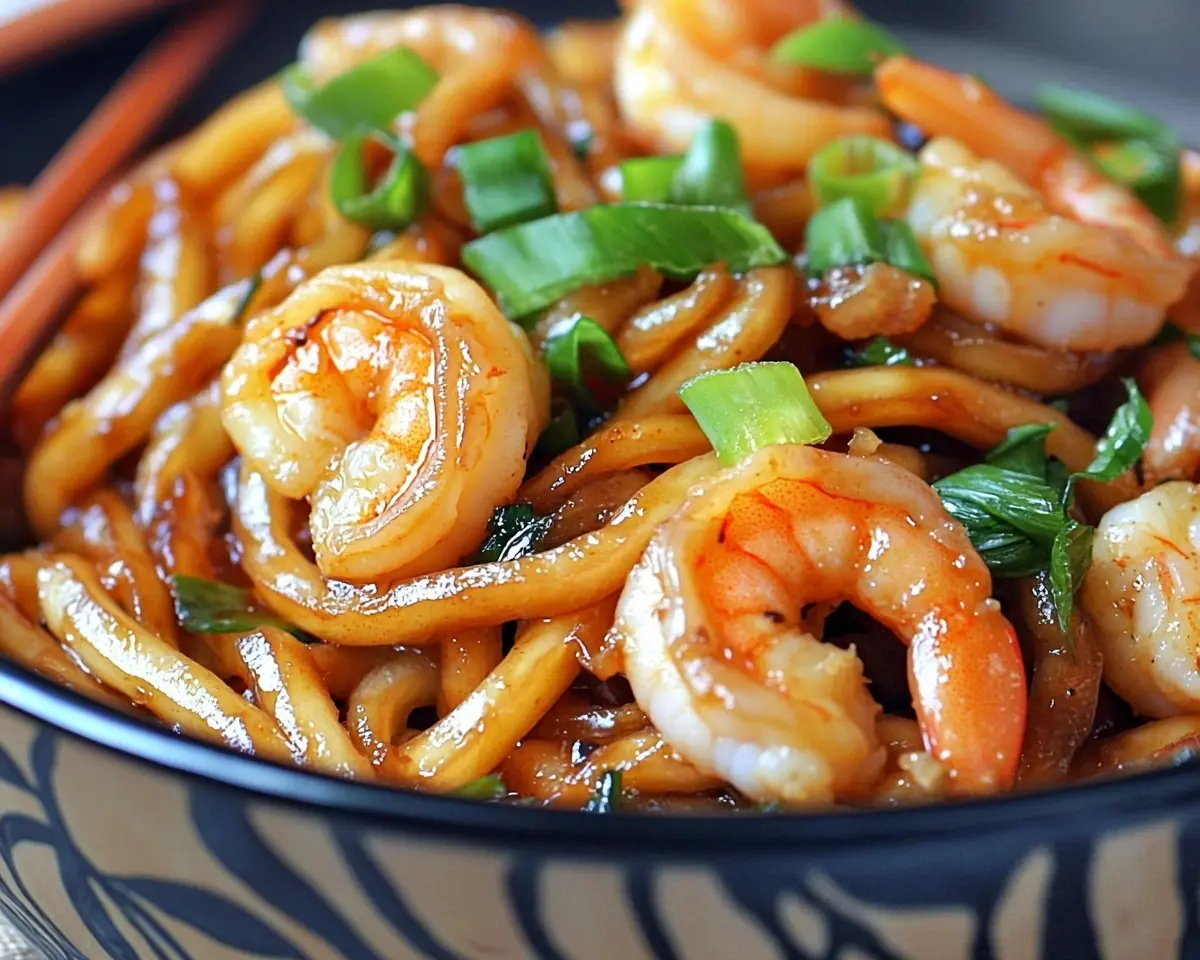Best Yaki Udon recipe with shrimp and vegetables. Quick 15-minute pasta noodle recipe for authentic Asian cooking at home.
Hi, I’m Linda, and welcome to Tasty at Home—where bold flavors meet everyday kitchens. Last month, while wandering through Seattle’s International District, the sizzling aroma of garlic and soy sauce pulled me into a tiny noodle shop. One bite of their yaki udon transported me straight to Tokyo’s bustling street food scene. Well, I knew I had to recreate that magic at home.
After burning through three pans and testing countless sauce ratios, I finally cracked the code. This best yaki udon recipe delivers restaurant-quality flavor in just 15 minutes. Whether you’re new to Asian cooking or a seasoned noodle lover, this dish will become your new obsession. Let me tell you, once you master this technique, takeout will never taste the same again.
Table of Contents
What Makes This Yaki Udon Recipe Special
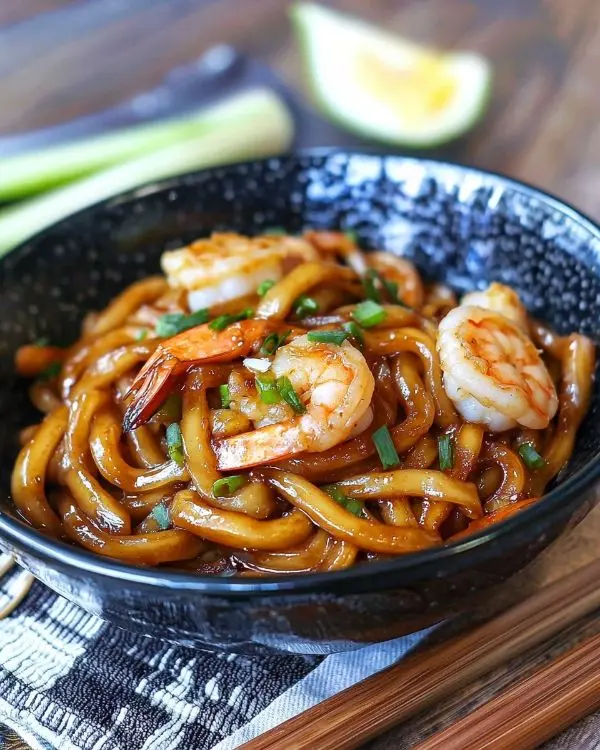
Unlike traditional pasta noodle recipes, yaki udon transforms humble ingredients into something extraordinary. Moreover, this Asian noodle dish celebrates the art of high-heat cooking, creating those coveted wok hei flavors right in your home kitchen. The secret lies in achieving the perfect balance between tender vegetables and slightly crispy noodles.
Furthermore, this recipe uses easily accessible ingredients from any US grocery store. You won’t need specialty equipment or hard-to-find seasonings. Instead, we focus on technique and timing to create authentic flavors that rival your favorite Japanese restaurant.
Additionally, I’ve tested this recipe with busy weeknight schedules in mind. From start to finish, you’ll have dinner ready in under 20 minutes. That’s faster than most delivery options, plus infinitely more satisfying.
Ingredient Quality and Selection
| Ingredient | Amount | US Measurement | Quality Tips |
|---|---|---|---|
| Udon noodles (vacuum-packed) | 1 pack | 7 oz | Choose fresh over dried for better texture |
| Shrimp | 8-10 pieces | 3.5 oz | Look for firm, sweet-smelling shrimp |
| Neutral oil | 3 tbsp | 3 tbsp | Vegetable or canola oil works best |
| Garlic | 1 clove | 1 clove minced | Fresh garlic only – avoid pre-minced |
| Yellow onion | 1 medium | 1 medium sliced | Sweet onions work wonderfully too |
| White mushrooms | 8 medium | 4 oz sliced | Button mushrooms are perfect |
| Carrot | 1 medium | 1 medium julienned | Choose firm, bright orange carrots |
| Spring onions | 2 stalks | 2 stalks chopped | Green onions, scallions work too |
| Regular soy sauce | 1 tbsp | 1 tbsp | Low-sodium preferred |
The Essential Sauce Components
| Sauce Ingredient | Amount | Purpose |
|---|---|---|
| Oyster sauce | 1 tbsp | Adds umami depth |
| Dark soy sauce | 1 tsp | Creates rich color |
| Rice vinegar | 1 tsp | Balances richness |
| Brown sugar | 1 tsp | Subtle sweetness |
| Black pepper | 1/3 tsp | Fresh heat |
| Sesame oil | 2 tsp | Aromatic finish |
When shopping at American grocery stores, you’ll find these ingredients in the international aisle. Consequently, most major chains like Safeway, Kroger, and Walmart carry quality Asian condiments. However, if you can’t locate dark soy sauce, regular soy sauce works in a pinch, though the color won’t be as rich.
Equipment and Preparation Essentials
This recipe requires minimal equipment, making it perfect for any home kitchen. First, you’ll need a large skillet or wok – preferably non-stick or well-seasoned cast iron. Next, gather a large pot for boiling noodles and a colander for draining.
Additionally, prep work makes all the difference in stir-fry cooking. Since everything moves quickly once you start cooking, having ingredients ready prevents burning. Therefore, slice all vegetables beforehand and mix your sauce in a small bowl.
Pro Equipment Tips
Using the right pan dramatically improves results. A 12-inch skillet provides enough surface area for proper browning. Moreover, carbon steel pans work exceptionally well for Asian cooking, developing natural non-stick properties over time. However, don’t stress if you only have a regular non-stick pan – it works perfectly fine.
One mistake I made early on involved overcrowding the pan. Oops! This steams vegetables instead of searing them, creating mushy textures. Instead, cook in batches if your pan seems too small. Trust me, this extra step makes a world of difference.
Step-by-Step Cooking Instructions
Preparing the Noodles
Start by boiling water in your largest pot. Once bubbling vigorously, add the udon noodles according to package directions. Typically, fresh udon needs only 2-3 minutes, while frozen varieties require 4-5 minutes.
Immediately drain and rinse with cold water to stop cooking. Then, drizzle lightly with oil to prevent sticking. This technique, borrowed from Julia Child’s pasta methods, ensures noodles maintain their texture during stir-frying.
Creating the Flavor Base
Heat one tablespoon oil in your skillet over medium-high heat. Add minced garlic, stirring constantly for about one minute until fragrant. You know it’s ready when the kitchen fills with that irresistible aroma.
Next, add sliced mushrooms to the hot pan. Cook on high heat, stirring frequently until they release moisture and develop golden edges. This takes approximately 3-4 minutes. Furthermore, resist the urge to move them constantly – let them sear properly.
Building Layers of Flavor
Add onions, white parts of spring onions, and julienned carrots to the mushroom mixture. Stir-fry for 2-3 minutes until vegetables begin to soften but retain their crunch. Season with salt and pepper, then transfer vegetables to a clean plate.
In the same pan, add remaining oil and increase heat to high. Add shrimp in a single layer, letting them sear undisturbed for 1-2 minutes. Flip and cook another minute until pink throughout. Sprinkle with soy sauce and salt for extra flavor.
The Critical Assembly
Now comes the magic moment. Add drained udon noodles to the pan with shrimp. Stir continuously over high heat, allowing noodles to develop slight charring – this creates authentic yaki udon flavor. The technique mirrors Thomas Keller’s approach to achieving perfect caramelization.
Pour the prepared sauce evenly over noodles, tossing quickly to coat everything uniformly. The sauce should sizzle and reduce slightly, creating a glossy coating. Finally, return vegetables to the pan and toss everything together one final time.
Finishing Touches
Remove from heat and immediately sprinkle with chopped green parts of spring onions. The residual heat wilts them perfectly while maintaining their bright color and fresh bite. Serve immediately while still steaming hot.
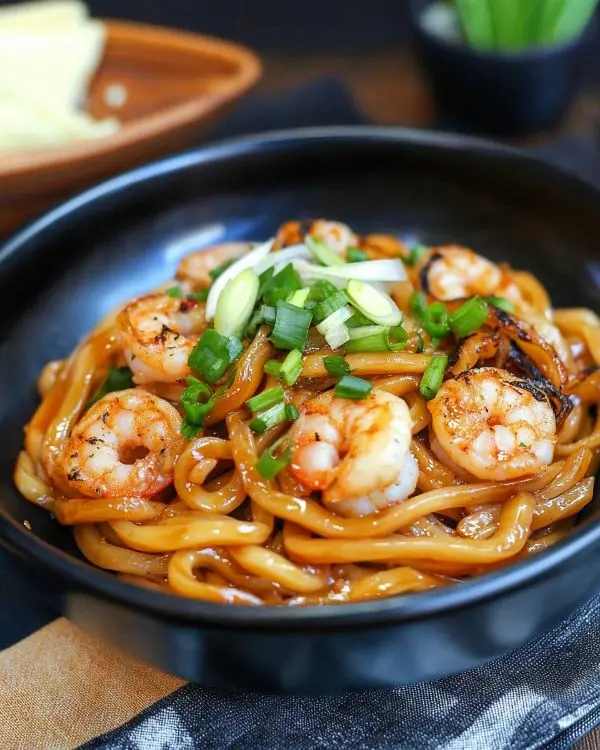
Expert Tips and Variations
Temperature Control Secrets
High heat is absolutely crucial for authentic yaki udon. However, if your stove runs hot, adjust accordingly to prevent burning. The goal is achieving that slightly smoky flavor without charring ingredients beyond recognition.
Moreover, preheating your pan properly makes a significant difference. A properly heated pan should sizzle immediately when you add oil. Consequently, this ensures proper searing rather than steaming.
Creative Variations
Protein Swaps: Replace shrimp with sliced chicken thighs, beef strips, or firm tofu. Pork belly works wonderfully too, adding rich flavor that complements the sauce beautifully.
Vegetable Alternatives: Bell peppers, snap peas, or baby corn create excellent textural variety. Additionally, cabbage adds satisfying crunch while stretching the recipe further.
Regional Adaptations: For a Southern twist, add sliced andouille sausage and bell peppers. Alternatively, create a Mexican fusion version with jalapeños and cilantro instead of spring onions.
Holiday Variations: During Thanksgiving, incorporate leftover turkey and cranberries for an unexpected fusion dish. Similarly, Christmas leftovers work beautifully in this adaptable recipe.
Storage and Make-Ahead Tips
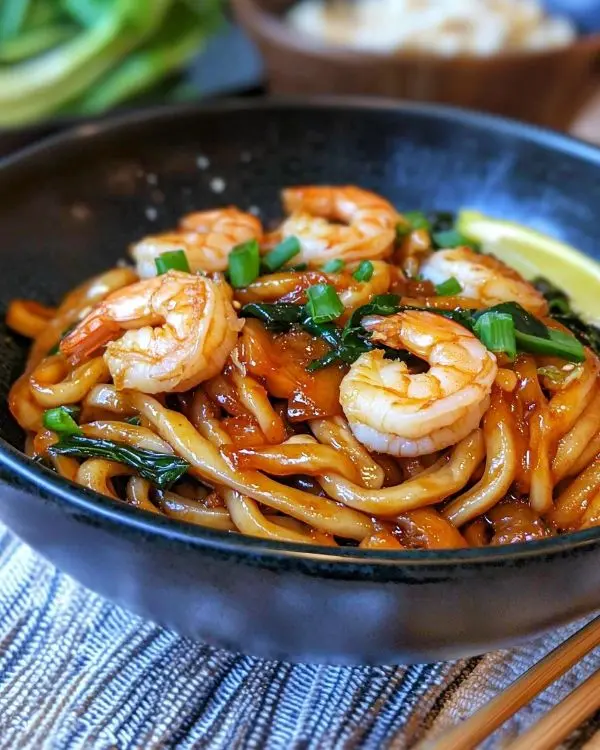
| Storage Method | Duration | Notes |
|---|---|---|
| Refrigerator | 3-4 days | Best when reheated in skillet |
| Freezer | 1 month | Texture changes slightly |
| Room temperature | 2 hours maximum | Food safety priority |
Yaki udon tastes best fresh, but leftovers reheat surprisingly well. Furthermore, adding a splash of water while reheating prevents noodles from drying out. However, avoid microwaving if possible – stovetop reheating maintains better texture.
For meal prep, cook components separately and combine when ready to eat. This prevents vegetables from becoming mushy during storage. Additionally, prepare extra sauce for refreshing flavors when reheating.
Yaki Udon Perfect Pairings
This versatile dish pairs beautifully with lighter appetizers and sides. Consider serving alongside whipped feta with honey for an unexpected Mediterranean-Asian fusion starter.
For a complete meal, try pairing with gyoza soup or Japanese chicken yakitori. These combinations create an authentic Japanese dining experience at home.
Beverage-wise, crisp white wines like Riesling or Pinot Grigio complement the dish’s umami flavors. Alternatively, Japanese beer or sake creates traditional pairing harmony.
Yaki Udon FAQs
What goes in yaki udon?
Traditional yaki udon contains thick wheat noodles, vegetables like cabbage and onions, protein such as pork or shrimp, and a savory sauce made with soy sauce and oyster sauce. The beauty lies in its adaptability to available ingredients.
What is the most popular udon?
In Japan, kitsune udon (with sweet seasoned tofu) remains most popular, while internationally, yaki udon and tempura udon dominate restaurant menus. Each style offers unique textures and flavor profiles.
What is the difference between yaki udon and udon?
Regular udon is served in hot broth as a soup, while yaki udon is stir-fried with vegetables and sauce. The cooking method creates completely different textures – soupy versus slightly crispy noodles.
Which udon brand is best?
For home cooking, vacuum-packed fresh udon from brands like Myojo or Sun Noodle provide superior texture compared to dried varieties. Many Asian markets carry these, though frozen options work well too.
Troubleshooting Common Mistakes
The most frequent error involves cooking over insufficient heat. Without proper temperature, vegetables steam instead of searing, creating mushy textures. Therefore, ensure your pan is properly preheated before adding ingredients.
Another common mistake is overcooking the noodles initially. Since they continue cooking during stir-frying, slightly undercooking them first prevents mushiness. Additionally, rinsing with cold water stops the cooking process completely.
Finally, adding sauce too early causes burning. Wait until the final moment to add sauce, allowing it to coat ingredients without scorching on the hot pan bottom.
The Perfect Finish
Man, oh man, there’s something magical about that first bite of perfectly executed yaki udon. The slight char on the noodles, the tender-crisp vegetables, and that glossy, umami-rich sauce create pure comfort food bliss. Whether you’re craving a quick weeknight dinner or impressing weekend guests, this recipe delivers every single time.
Remember that autumn evening when I first tasted yaki udon in Seattle? Now I can recreate that same satisfaction whenever the craving strikes. The best part? It costs a fraction of restaurant prices while tasting even better.
So grab your chopsticks, turn up that heat, and prepare for your new favorite Asian noodle obsession. Don’t forget to tag us when you make it – we love seeing your creative variations and perfect noodle shots!
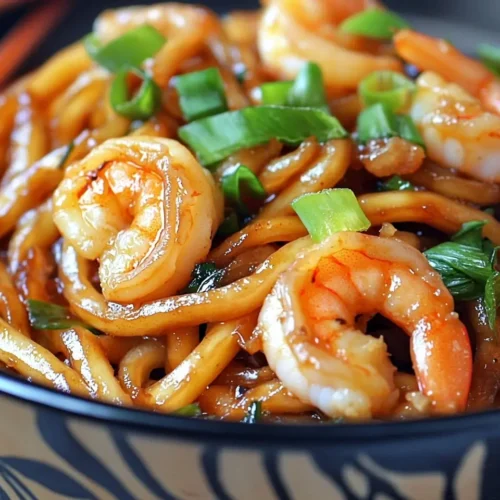
Best Yaki Udon
Equipment
- Large pot
- Colander
- Large skillet or wok
- Knife
- Cutting board
- Small mixing bowl
Ingredients
Main Ingredients
- 1 pack (7 oz) Udon noodles (vacuum-packed) Fresh preferred
- 8-10 pieces (3.5 oz) Shrimp Firm, sweet-smelling
- 3 tbsp Neutral oil Vegetable or canola
- 1 clove Garlic Minced, fresh only
- 1 medium Yellow onion Sliced
- 8 medium (4 oz) White mushrooms Sliced
- 1 medium Carrot Julienned
- 2 stalks Spring onions Chopped
- 1 tbsp Regular soy sauce Low-sodium preferred
Sauce
- 1 tbsp Oyster sauce Adds umami depth
- 1 tsp Dark soy sauce For color
- 1 tsp Rice vinegar Balances richness
- 1 tsp Brown sugar Subtle sweetness
- ⅓ tsp Black pepper Freshly ground
- 2 tsp Sesame oil Aromatic finish
Instructions
- Boil udon noodles according to package directions, drain, rinse with cold water, and drizzle with a little oil to prevent sticking.
- Heat 1 tbsp oil in a skillet or wok. Add garlic and cook for 1 minute until fragrant, then add mushrooms. Cook until golden, about 3-4 minutes.
- Add onions, carrots, and white parts of spring onions. Stir-fry 2-3 minutes until slightly softened. Transfer vegetables to a plate.
- In the same pan, heat remaining oil. Add shrimp in a single layer, sear 1-2 minutes per side until pink. Season with soy sauce and salt.
- Add noodles to the pan with shrimp. Stir-fry over high heat until slightly charred. Pour in sauce and toss to coat evenly.
- Return vegetables to the pan, toss everything together, and remove from heat. Garnish with green parts of spring onions. Serve hot.

